
|
|

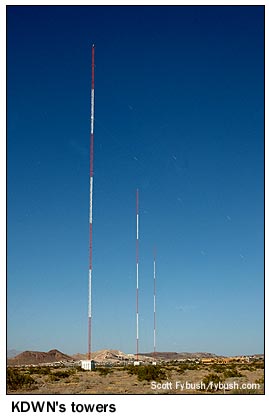 November 24, 2006
November 24, 2006
KDWN 720 and KLSQ 870, Las Vegas, Nevada
This month, we're kicking off a brand-new season of sites that have never before been seen on Tower Site of the Week - and a few weeks ago found us up on Mount Potosi outside Las Vegas, another one of the sites featured in Tower Site Calendar 2007.
This week, we feature two Las Vegas AM sites that we'd only seen previously from a considerable distance: KLSQ (870 Whitney) and KDWN (720 Las Vegas).
When we first set out to visit the "sticks of Sin City" back in 2001, the KDWN towers were unreachable by paved road, out in the middle of a whole bunch of empty land north of Highway 146 near Henderson.
But the great thing about tower hunting in Las Vegas is that what's inaccessible on one trip may well end up just off the side of a four-lane divided highway the next time out - and indeed, when our little caravan of tower hunters came back down from our excursion to Black Mountain that we featured last week (go visit it again - it's been updated with new information!), we found that KDWN's three towers now sit in the middle of a huge new housing development, with paved road right up to the driveway to the transmitter buildings.
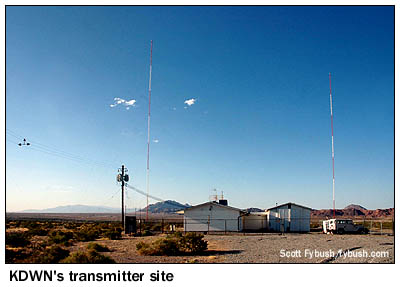 These
three 347-foot towers went up in 1975, when A.J. Williams' Radio
Nevada won the construction permit for a brand-new 50 kW signal,
one of the Class II-A stations authorized as part of the breakdown
of the clear channels.
These
three 347-foot towers went up in 1975, when A.J. Williams' Radio
Nevada won the construction permit for a brand-new 50 kW signal,
one of the Class II-A stations authorized as part of the breakdown
of the clear channels.
While many of the II-A signals that came on the air in that era were existing stations that upgraded (KRVN in Nebraska, KOFI in Montana, KBOI in Boise), Williams' new "K-Dawn" was brand new to the air, playing soft adult contemporary music with 50,000 non-directional watts by day, using all three towers at night to protect the established signal on 720, WGN. (It signed on with 10 kilowatts at night, upgrading to 50 kW fulltime in the early eighties.)
We'll come back to KDWN in a bit, but first we head to the last truly inaccessible AM site in Las Vegas - inaccessible, that is, without a 4-wheel-drive vehicle and a crazy friend at the wheel.
Bumping over railroad tracks, rocks and a mile or two of barely-graded desert, we completed our day of tower-hunting out at the three towers of KLSQ, tucked in between US 93/95 and the eastern slopes of Black Mountain. (Those are the Black Mountain TV and FM towers you see off in the distance behind KLSQ's three 287' towers.)
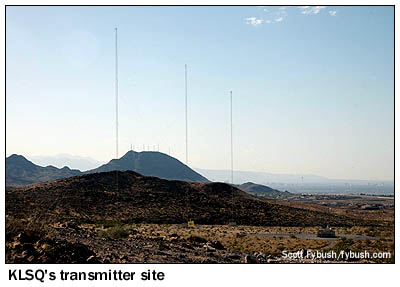
|
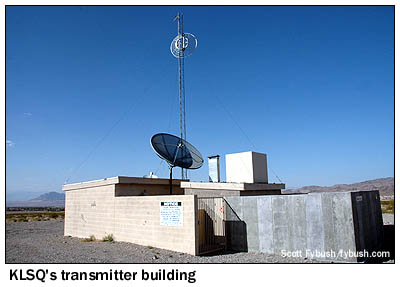
|
That you can even see the KLSQ towers is somewhat remarkable. In order to get local permission to build them, they were painted a deep gold color that simply blends into the desert from most viewing angles, to the point that we almost lost sight of them as we were bumping our way out the desert roads to get here. (Note the absence of power lines, too - KLSQ runs entirely on generator power, apparently.)
A quick bit of history before we move on: this site came on the air as a synchronous repeater of what was then KROL, Laughlin, a signal that didn't reach the hundred miles north to Las Vegas. With 5 kW by day and 430 watts at night, the repeater (then licensed to "East Las Vegas," an unincorporated community that later became Whitney) solved that problem, and under the present Univision Radio ownership, the Laughlin signal went away and the station ended up licensed to Whitney with this as its sole transmitter site.
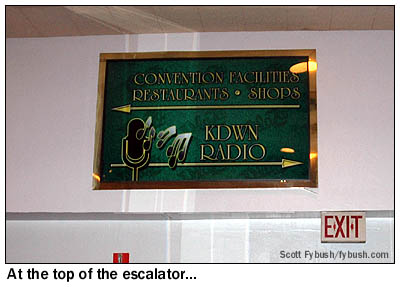
|
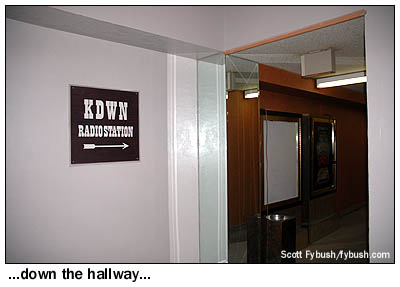
|
On this trip, we have a special reason for wanting to come back to KDWN before we say goodbye to Las Vegas. After 30 years of local ownership, A.J. Williams died in 2005, with the station being put up for sale not long afterward. Just a few weeks before the NAB Show brought us to Vegas in April 2006, Beasley Broadcasting agreed to pay $17 million to Williams' heirs for KDWN, setting the stage for some big changes to the station.
As anyone who listened to KDWN under Williams' ownership was well aware (from the distinctive top-hour IDs), KDWN proudly maintained its studios "at the Plaza Hotel, Number One Main Street." We'd never been there, and knowing that we'd never get another chance, we made it a point to stop by and see the place on our last day at the convention. From the rundown casino floor, an escalator leads up to the second story - and down an orange-painted hallway, we find the homey lobby that looks like it's still 1975.
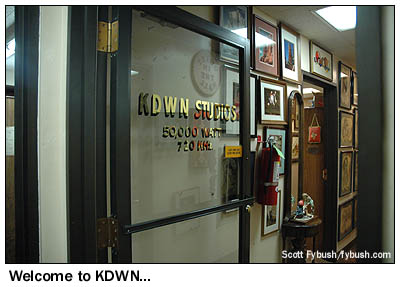
|
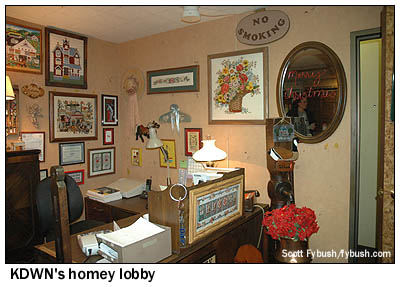
|
On a tour down the hallway to the studio, we see the pictures and awards that Williams collected over the years. There was once a collecton of vintage microphones, too, we're told, but it was moved elsewhere after Williams' death.
The studio complex, too, is pretty much straight out of 1975 - rotary pots, lots of carts, even more reels of tape, and not a bit of computer automation to be seen. That's Tru Hawkins punching up a cart in the air studio during his midday talk show, which mixed local politics with an increasing amount of paid programming, which may explain why the station's ratings toward the end were surprisingly low for a 50-kilowatt blowtorch signal. (That wasn't always the case; KDWN was the launching pad for a talk host named Art Bell at the start of his career, and it was the first home of Rush Limbaugh in the market, too, in addition to being the longtime home for L.A. Dodgers games. More recently, we could always count on KDWN for some of the most conservative local talk on the dial anywhere, sometimes to the point of self-parody.)
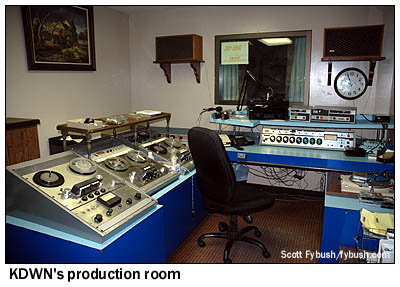
|
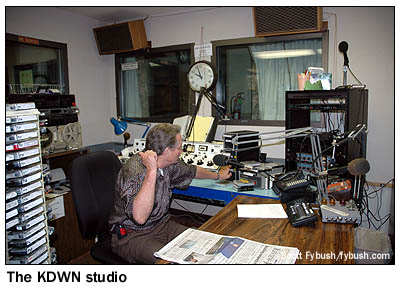
|
By the time we stopped by to say hello, most of KDWN's staff knew it was a goodbye visit as well. Beasley had made it clear that it was taking the station in a different direction, and by the autumn of 2006, the Plaza Hotel studios were empty and Tru Hawkins had moved away to Texas.
 KDWN now operates
from new studios in the Beasley offices on East Tropicana, with
a schedule of mostly syndicated talk hosts, including Neal Boortz
and Michael Savage. It may sound slicker on the air, but I'm
glad I got to see the "old" KDWN too, before it was
all gone.
KDWN now operates
from new studios in the Beasley offices on East Tropicana, with
a schedule of mostly syndicated talk hosts, including Neal Boortz
and Michael Savage. It may sound slicker on the air, but I'm
glad I got to see the "old" KDWN too, before it was
all gone.
The Tower Site Calendar 2007 is here! It's not just Mount Potosi - but a dozen more great photos of transmitter sites near and far. Be one of the first to receive your copy - order today at the Fybush.com Store!
- Previous Site of the Week: Black Mountain, Las Vegas, NV
- Next Week: TBA
- Site of the Week INDEX!
- How can you help support Site of the Week? Click here!
- Submit your suggestions for a future Site of the Week!
